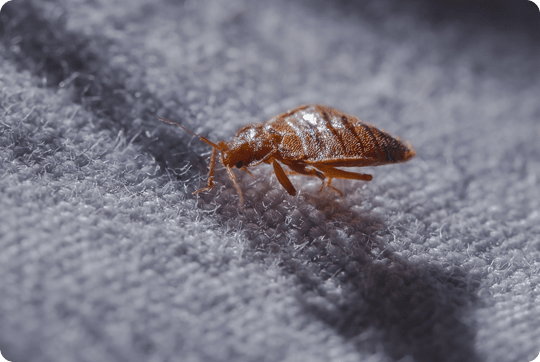Many places are suitable for bed bugs to hide. This makes them challenging to detect and get rid of. We will take a look at six surprising places where bed bugs may hide. Knowing those uncommon bed bug hiding places will help you prevent infestations in your home. You will also find it easier to find them if an infestation has already taken place. This article was written with the help of reliable bed bug control experts.
Table of Contents
The Unexpected Places Where You Can Find Bed Bugs
Bed bugs aren’t only considered masters of reproduction. They are very skilled in hiding too. Here are just some of the places that one shouldn’t expect to find bed bugs. But believe us when we tell you – locating them in these places is very possible!
1. Electrical Outlets and Switch Plates
It can seem very unusual to find bed bugs in electrical outlets and switch plates. Narrow places are no problem for them. It has to do with their small size. They will be hard to see with the naked eye. You will need a flashlight and a magnifying glass. It will be easier to inspect outlets and switch plates this way.
Look for live bugs, shed skins and faecal spots. Consider installing bed bug-proof outlet covers or plates. They prevent bed bugs from crawling through electrical fixtures. Make sure to regularly hoover and clean around outlets. As a result, bed bugs will be less likely to infest those areas.
Find out the best ways to keep your home pest-free!
2. Behind Picture Frames and Wall Decor
Bed bugs are experts at hiding in cracks and crevices. They can also be found behind picture frames and wall decor. They can easily find shelter in these places. Moreover, they are close to their human hosts. This makes those odd hiding spots ideal for bed bugs. Remove wall decor and picture frames and inspect them for signs of bed bugs. Pay special attention to edges, seams and hanging hardware.
It’s highly recommended that you seal cracks and gaps around picture frames and wall decor. This will prevent bed bugs from entering and hiding in those spots. Another thing you can do is to hoover and clean the walls regularly. By doing so, you will ensure to remove bed bugs and their eggs from these areas.
3. Inside Luggage and Backpacks
These invasive insects can also hide inside luggage and backpacks. The risk is higher if you have traveled to or stayed in infested places. Bed bugs can attach onto clothes, bedding or other personal belongings. After that, they can find a way and enter your backpacks or luggage without you knowing. Inspect your luggage and backpacks thoroughly after travelling. Focus on inspecting pockets, seams and zippers.
We recommend using bed bug-proof luggage covers and liners. They are great at preventing bed bugs from infesting your stuff during travel. When you get home, unpack your belongings outside. Wash clothes and bedding in hot water. This will kill bed bugs along with their eggs.
Check our helpful article about how to detect and control carpet beetles!
4. Within Books and Paper Products
Paper products like books and magazines can also get invaded bed bugs. Chances are high if these items are stored in an infested area or if they are moved in different places. These bugs can hide between pages, covers and bindings. It’s very difficult to notice them in paper products. It’s highly advisable for books and magazines to be regularly inspected. Faecal spots and very small crawling insects are things you should be looking for.
Store paper products in sealed plastic containers or bags. This way you will greatly reduce the chances of bed bugs accessing paper items. If you notice bed bugs in books or other paper items – treat them with cold or heat. By doing this, you will eliminate them for good.
5. Inside Electronic Devices and Appliances
Appliances and electronic devices can also be a good shelter for bed bugs. Especially if they offer a warm and isolated environment. They can find shelter in televisions, computers, kitchen appliances, and more. You can find it difficult to find their presence in them. Check electronics and kitchen appliances from time to time. Look for small bugs and faecal spots near vents and openings.
We advise you to use compressed air or a hoover with a nozzle attachment and go over dirty or infested appliances. Clean them thoroughly to ensure they are perfectly clean. Seal openings and cracks with tame or sealant. This will prevent insects from entering these hidden areas.
6. Within Furniture Joints and Upholstery
Many people know that furniture is one of the most common hiding places for bed bugs. These little insects can hide in seams, furniture joints and upholstery. This makes detecting and removing bed bugs very difficult. Like always, regular inspections are very important. Check your furniture regularly for bed bug signs. Once again, look for blood stains, faecal spots and live bugs.
Protect your mattress, box springs, and upholstered furniture from bed bugs. Invest in bed bug encasements. Hoover and steam clean your furniture regularly. This will eliminate any hidden bed bugs and their eggs. Cleaning is also a great way to reduce the risk of infestations.
Conclusion
Bed bugs have an almost unbeatable ability to hide in a wide range of unexpected places. That’s why it’s very important to understand their nature. When you get to know where they may hide, you can protect your property from infestations. Regular inspections and cleaning are a must. These are two simple measures that work wonders and ensure a pest-free environment. It’s best to contact professional pest control experts if you suspect bed bug infestations. They know how to handle these insects and how to further protect your home from them.

